Precision Solar Spectrum Filtering in Aerogel Windows via Synergistic ITO-Ag Nanoparticle Doping for Hot-Climate Energy Efficiency
Abstract
1. Introduction
2. Results and Discussion
2.1. Model Validation
2.2. Engineering the Plasmonic Building Blocks for Spectral Control
2.3. Synergistic Doping: Achieving Superior Spectral Selectivity
2.4. Optimization Towards Peak Performance
2.5. Quantifying the Real-World Impact: Building Energy Savings
2.6. Economic Evaluation of Silica Aerogel Window
3. Conclusions
- Utilizing the LSPR effect, the morphology of Ag nanocylinders is adjusted to achieve precise absorption of NIR in the 0.78–0.9 μm range, while ITO nanoparticles are adjusted to block UV and a wide range of NIR. The optimized plasmonic aerogel achieves an exceptional balance of properties, including a luminous transmittance of 0.8, a haze below 0.12, and an LSG ratio of 0.91.
- System-level simulations confirm the real-world impact of this design, projecting significant annual energy savings of up to 40% for buildings in hot climates when compared to conventional glazing.
- The economic analysis demonstrates that silica aerogel energy-saving glass can achieve cost savings of up to 20,433.6 RMB/m2 compared to conventional glass, highlighting its significant energy efficiency benefits.
4. Materials and Methods
4.1. Conceptual Design and Physical Principles
4.2. Radiative Properties of Individual Nanoparticles
4.3. Radiative Transfer in the Composite Aerogel
4.4. Window Performance Metrics
4.5. Building Energy Consumption Simulations
4.6. Economic Evaluation Method
Author Contributions
Funding
Institutional Review Board Statement
Informed Consent Statement
Data Availability Statement
Conflicts of Interest
Abbreviations
| A | absorptance |
| C | cross-section |
| DDA | discrete dipole approximation |
| E | energy consumption |
| ESR | energy saving ratio |
| fv | particle volume fraction |
| F0 | incident flux |
| g | asymmetry factor |
| Id(τ,μ) | the diffuse intensity |
| IAM1.5(λ) | solar irradiation intensity |
| LSG | light to solar heat gain ratio |
| MC | the Monte Carlo method |
| n | refractive index |
| Q | efficiency factor |
| reff | effective radius of a cluster of monodispersed spheres, nm |
| T | transmittance |
| V(λ) | standard luminous efficiency function |
| β | coefficient, m−1 |
| θ | polar angle, ° |
| λ | wavelength, μm |
| μ | cosine of the polar angle |
| ρ | visible light |
| σT | deviation from the ideal spectrum |
| τ | optical coordinat |
| ω | the single scattering albedo |
| abs | absorption |
| base | base window |
| cool | cooling |
| eff | effective |
| heat | heating |
| lum | luminous |
| m | medium |
| p | particle |
| sca | scattering |
| sol | solar |
References
- Buratti, C.; Belloni, E.; Merli, F.; Zinzi, M. Aerogel glazing systems for building applications: A review. Energy Build. 2021, 231, 110587. [Google Scholar] [CrossRef]
- Streltsov, A.; Malof, J.M.; Huang, B.; Bradbury, K. Estimating residential building energy consumption using overhead imagery. Appl. Energy 2020, 280, 116018. [Google Scholar] [CrossRef]
- Wenninger, S.; Kaymakci, C.; Wiethe, C. Explainable long-term building energy consumption prediction using QLattice. Appl. Energy 2022, 308, 118300. [Google Scholar] [CrossRef]
- Li, X.; Zhang, Z.; Zhang, X.; Cao, Y.; Yang, Y.; Wang, W.; Wang, J. A polymer nanocomposite with strong full-spectrum solar absorption and infrared emission for all-day thermal energy management and conversion. Adv. Sci. 2024, 11, 202308200. [Google Scholar] [CrossRef]
- Wan, K.K.; Li, D.H.; Liu, D.; Lam, J.C. Future trends of building heating and cooling loads and energy consumption in different climates. Build. Environ. 2011, 46, 223–234. [Google Scholar] [CrossRef]
- Xie, B.; Liu, L. In3SbTe2-based all-season smart film with synergistic modulation of solar and thermal radiation. Appl. Phys. Lett. 2025, 126, 111701. [Google Scholar] [CrossRef]
- Yu, S.; Yu, J.-S.; Chen, Z.; Li, Q.; Wang, Z.; Luo, X.; Kim, S.-K.; Hu, R. Ultrahigh visible-transparency, submicrometer, and polymer-free radiative cooling meta-glass coating for building energy saving. ACS Photonics 2024, 11, 3412–3423. [Google Scholar] [CrossRef]
- Liu, X.; Zhang, H.; Pan, Y.; Ma, J.; Liu, C.; Shen, C. A transparent polymer-composite film for window energy conservation. Nano-Micro Lett. 2025, 17, 151. [Google Scholar] [CrossRef]
- Cotana, F.; Pisello, A.L.; Moretti, E.; Buratti, C. Multipurpose characterization of glazing systems with silica aerogel: In-field experimental analysis of thermal-energy, lighting and acoustic performance. Build. Environ. 2014, 81, 92–102. [Google Scholar] [CrossRef]
- Fang, W.Z.; Zhang, H.; Chen, L.; Tao, W.Q. Numerical predictions of thermal conductivities for the silica aerogel and its composites. Appl. Therm. Eng. 2017, 115, 1277–1286. [Google Scholar] [CrossRef]
- Gu, X.; Ling, Y.Q. Research progress of aerogel materials in the field of construction. Alex. Eng. J. 2024, 91, 620–631. [Google Scholar] [CrossRef]
- Alattar, A.M. Spectral and structural investigation of silica aerogels properties synthesized through several techniques. J. Non-Cryst. Solids 2021, 571, 121048. [Google Scholar] [CrossRef]
- Fu, T.; Tang, J.; Chen, K.; Zhang, F. Visible, near-infrared and infrared optical properties of silica aerogels. Infrared Phys. Technol. 2015, 71, 121–126. [Google Scholar] [CrossRef]
- Shandurkov, D.; Danchova, N.; Spassov, T.; Petrov, V.; Tsekov, R.; Gutzov, S. Silica gels doped with gold nanoparticles: Preparation, structure and optical properties. Gels 2023, 9, 663. [Google Scholar] [CrossRef] [PubMed]
- Wang, T.; Si, Q.; Hu, Y.; Tang, G.; Chua, K.J. Silica aerogel composited with both plasmonic nanoparticles and opacifiers for high-efficiency photo-thermal harvest. Energy 2023, 265, 126371. [Google Scholar] [CrossRef]
- Ameen, K.B.; Rajasekharan, T.; Rajasekharan, M.V. Grain size dependence of physico-optical properties of nanometallic silver in silica aerogel matrix. J. Non-Cryst. Solids 2006, 352, 737–746. [Google Scholar] [CrossRef]
- Yu, X.; Huang, M.; Wang, X.; Tang, G.H.; Du, M. Plasmon silica aerogel for improving high-temperature solar thermal conversion. Appl. Therm. Eng. 2023, 219, 119419. [Google Scholar] [CrossRef]
- Yu, X.; Huang, M.; Wang, X.; Sun, Q.; Tang, G.H.; Du, M. Toward optical selectivity aerogels by plasmonic nanoparticles doping. Renew. Energy 2022, 190, 741–751. [Google Scholar] [CrossRef]
- Pu, J.H.; Yu, X.; Zhao, Y.; Tang, G.; Ren, X.; Du, M. Dynamic aerogel window with switchable solar transmittance and low haze. Energy 2023, 285, 129437. [Google Scholar] [CrossRef]
- Stuart-Fox, D.; Newton, E.; Clusella-Trullas, S. Thermal consequences of colour and near-infrared reflectance. Philos. Trans. R. Soc. B Biol. Sci. 2017, 372, 20160345. [Google Scholar] [CrossRef]
- Rashad, M.; Żabnieńska-Góra, A.; Norman, L.; Jouhara, H. Analysis of energy demand in a residential building using TRNSYS. Energy 2022, 254, 124357. [Google Scholar] [CrossRef]
- Jana, J.; Ganguly, M.; Pal, T. Enlightening surface plasmon resonance effect of metal nanoparticles for practical spectroscopic application. RSC Adv. 2016, 6, 86174–86211. [Google Scholar] [CrossRef]
- Zhao, L.; Yang, S.; Bhatia, B.; Strobach, E.; Wang, E.N. Modeling silica aerogel optical performance by determining its radiative properties. AIP Adv. 2016, 6, 025123. [Google Scholar] [CrossRef]
- Draine, B.T.; Flatau, P.J. Discrete-Dipole Approximation for Scattering Calculations. J. Opt. Soc. Am. 1994, 11, 1491–1499. [Google Scholar] [CrossRef]
- Mishchenko, M.I.; Travis, L.D. Capabilities and limitations of a current FORTRAN implementation of the T-matrix method for randomly oriented, rotationally symmetric scatterers. J. Quant. Spectrosc. Radiat. Transfer. 1998, 60, 309–324. [Google Scholar] [CrossRef]
- Wrigglesworth, E.G.; Johnston, J.H. Mie theory and the dichroic effect for spherical gold nanoparticles: An experimental approach. Nanoscale Adv. 2021, 3, 3530–3536. [Google Scholar] [CrossRef]
- Qi, X.; Nieminen, T.A.; Stilgoe, A.B.; Loke, V.L.Y.; Rubinsztein-Dunlop, H. Comparison of T-matrix calculation methods for scattering by cylinders in optical tweezers. Opt. Lett. 2014, 39, 4827–4830. [Google Scholar] [CrossRef]
- Xie, T.; He, Y.-L. Heat transfer characteristics of silica aerogel composite materials: Structure reconstruction and numerical modeling. Int. J. Heat Mass Transf. 2016, 95, 621–635. [Google Scholar] [CrossRef]
- Leroy, A.; Bhatia, B.; Sircar, J.; Wang, E. Thermal transport in solar-reflecting and infrared-transparent polyethylene aerogels. Int. J. Heat Mass Transf. 2022, 184, 122307. [Google Scholar] [CrossRef]
- Kamiuto, K. Study of the Henyey-Greenstein approximation to scattering phase functions. J. Quant. Spectrosc. Radiat. Transf. 1987, 37, 411–413. [Google Scholar] [CrossRef]
- Huang, M.; Tang, G.; Ren, X.; Sun, Q.; Du, M. Effects of microstructure and moisture content on the radiative properties of porous films for radiative cooling. Sol. Energy 2023, 262, 111855. [Google Scholar] [CrossRef]
- Yu, X.; Ren, X.; Wang, X.; Tang, G.; Du, M. A high thermal stability core–shell aerogel structure for high-temperature solar thermal conversion. Compos. Commun. 2023, 37, 101440. [Google Scholar] [CrossRef]
- Cheng, Z.; Wang, F.; Wang, H.; Liang, H.; Ma, L. Effect of embedded polydisperse glass microspheres on radiative cooling of a coating. Int. J. Therm. Sci. 2019, 140, 358–367. [Google Scholar] [CrossRef]
- Bao, Y.; Huang, Y.; Li, W.; Zhu, K. Combination of the Monte Carlo method and DDA to evaluate the radiative properties of ITO- pigmented and TiO2-pigmented coatings. Int. J. Therm. Sci. 2019, 146, 106076. [Google Scholar] [CrossRef]
- Park, S.-H.; Kim, J.; Kim, M.J.; Kim, M.W.; Taylor, R.A.; Kyhm, K. Complex Refractive Index Spectrum of CsPbBr3 Nanocrystals via the Effective Medium Approximation. Nanomaterials 2025, 15, 181. [Google Scholar] [CrossRef] [PubMed]
- Lin, C.; Hur, J.; Chao, C.Y.H.; Liu, G.; Yao, S.; Li, W.; Huang, B. All-weather thermochromic windows for synchronous solar and thermal radiation regulation. Sci. Adv. 2022, 8, eabn7359. [Google Scholar] [CrossRef]
- Du, M.; Yang, H.; Huang, J.; Tang, G.; Zhang, X.; Niu, D. Effects of Moisture Content on the Radiative Properties and Energy-Saving Performance of Silica Aerogel Windows. Langmuir 2024, 40, 20273–20283. [Google Scholar] [CrossRef]
- Liu, X.; Shen, C.; Wang, J. Investigation on the lighting/heating performance of tubular daylighting devices (TDDs) based on nanofluids. Energy Build. 2022, 263, 112028. [Google Scholar] [CrossRef]
- Pu, J.; Han, M.; Lu, L.; Shen, C.; Wang, F. Spectrally selective design and energy-saving demonstration of a novel liquid-filled window in hot and humid region. Energy 2024, 297, 131090. [Google Scholar] [CrossRef]
- Yao, P.; Yang, R.; Sun, Q.; Tang, G.; Liu, X.; Pu, J.H.; Du, M. Transparent photothermal films with high optical selectivity for anti/de-icing. Appl. Therm. Eng. 2024, 242, 122490. [Google Scholar] [CrossRef]
- Souayfane, F.; Biwole, P.H.; Fardoun, F.; Achard, P. Energy performance and economic analysis of a TIM-PCM wall under different climates. Energy 2019, 169, 1274–1291. [Google Scholar] [CrossRef]
- Yu, J.; Yang, C.; Tian, L.; Liao, D. A study on optimum insulation thicknesses of external walls in hot summer and cold winter zone of China. Appl. Energy 2009, 86, 2520–2529. [Google Scholar] [CrossRef]
- Jiang, W.; Liu, B.; Zhang, X.; Zhang, T.; Li, D.; Ma, L. Energy performance of window with PCM frame. Sustain. Energy Technol. Assess. 2021, 45, 101109. [Google Scholar] [CrossRef]
- Li, Q.; Ma, L.; Li, D.; Arıcı, M.; Yıldız, Ç.; Wang, Z.; Liu, Y. Thermoeconomic analysis of a wall incorporating phase change material in a rural residence located in northeast China. Sustain. Energy Technol. Assess. 2021, 44, 101091. [Google Scholar] [CrossRef]

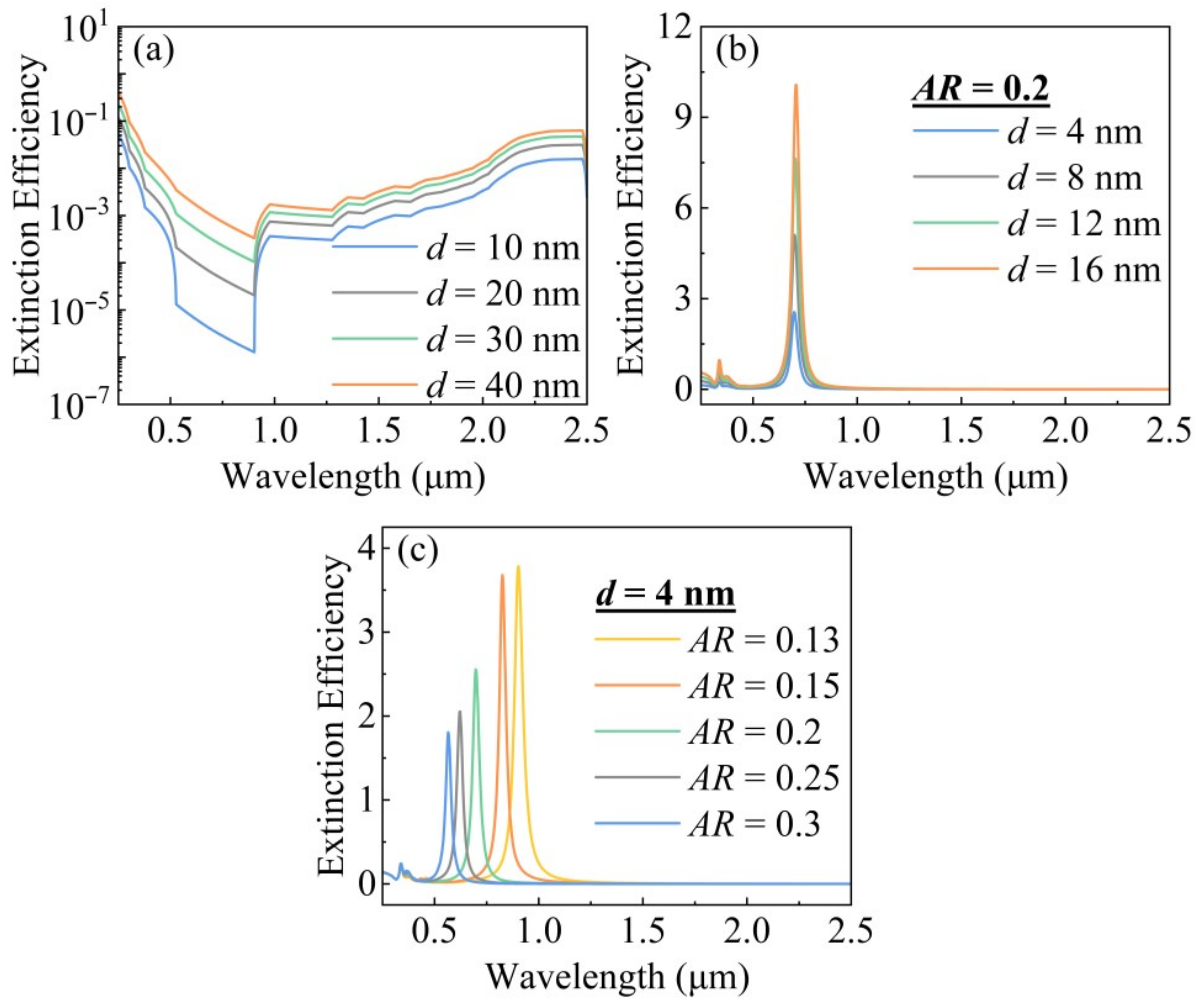
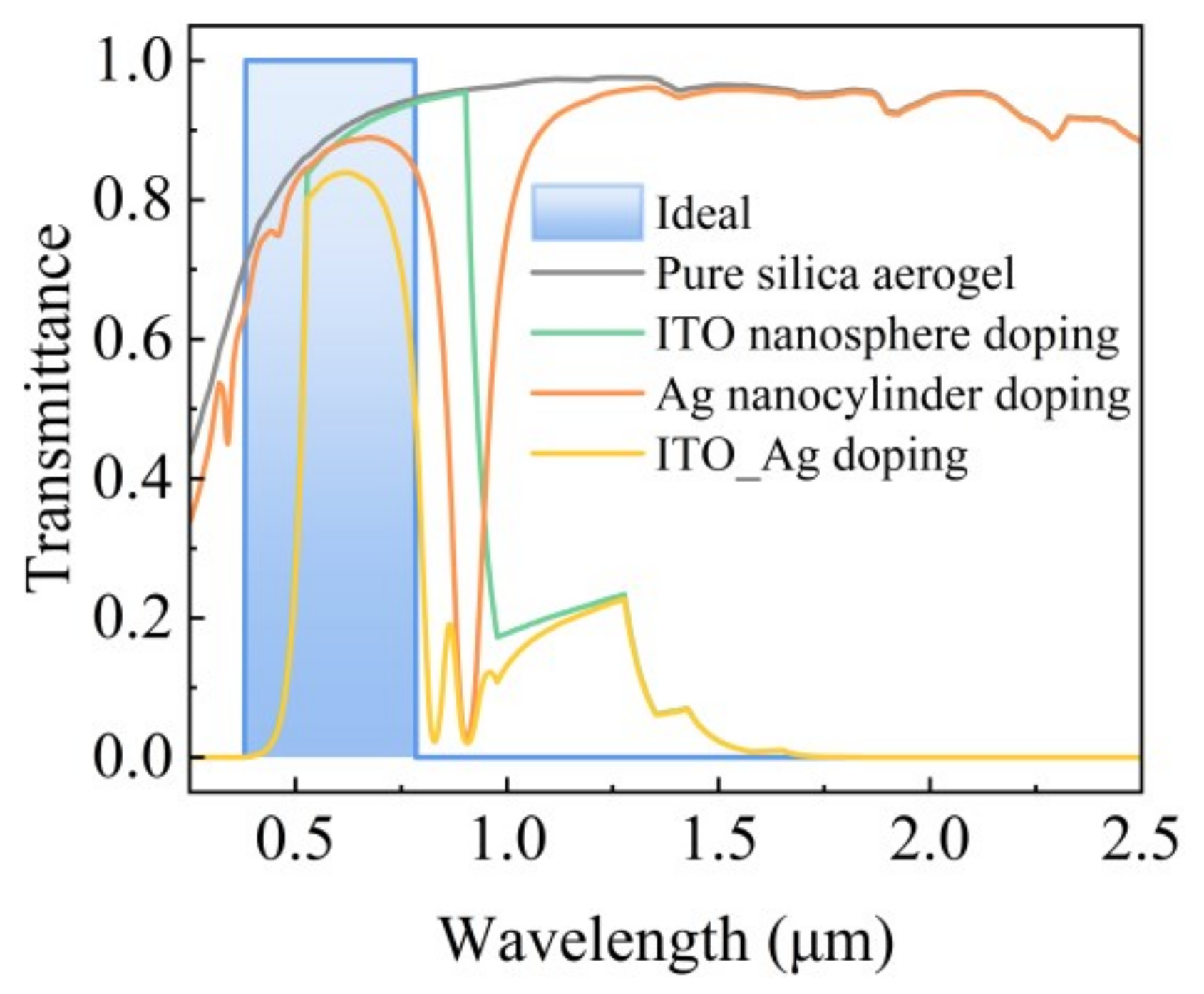
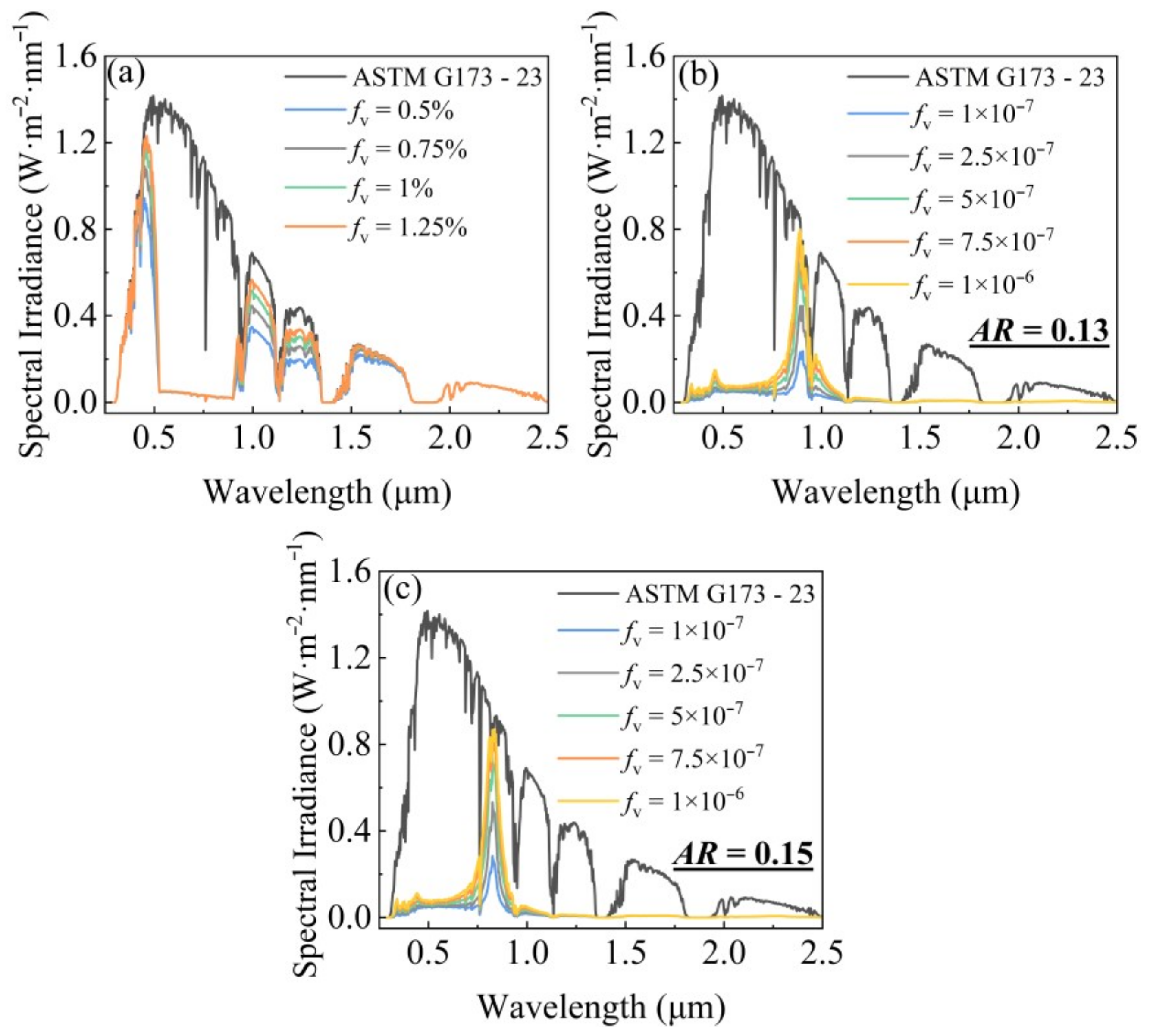
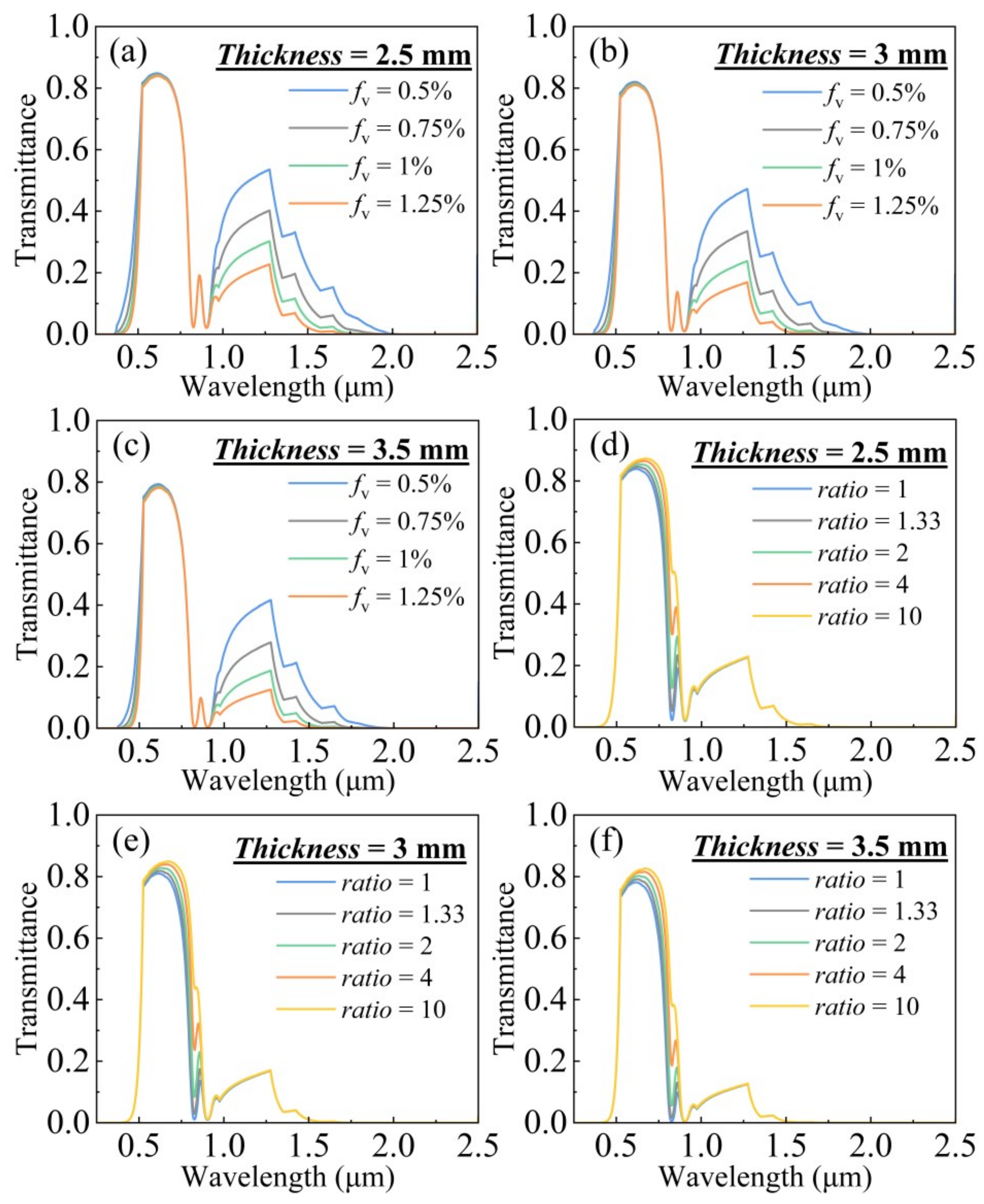
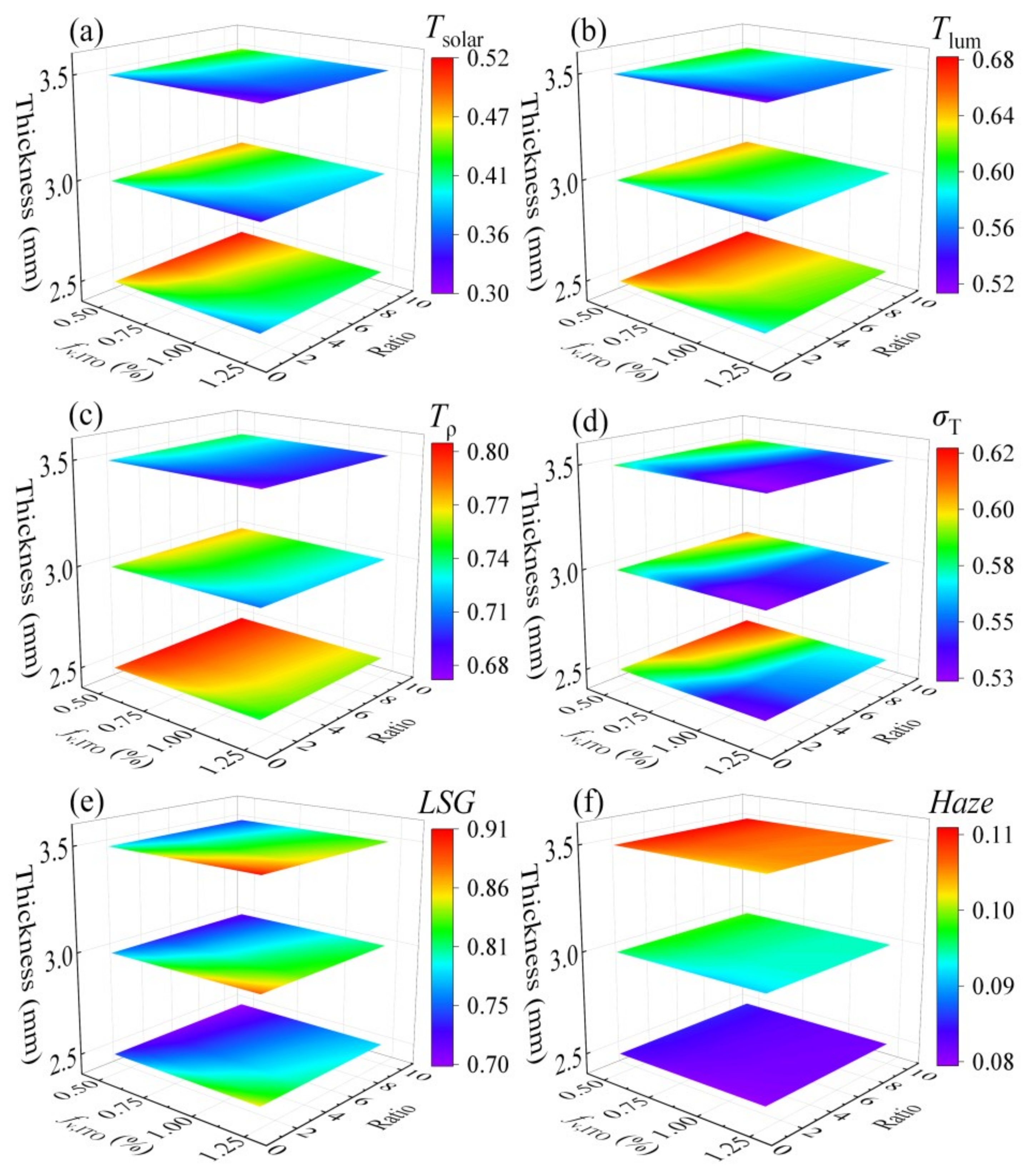
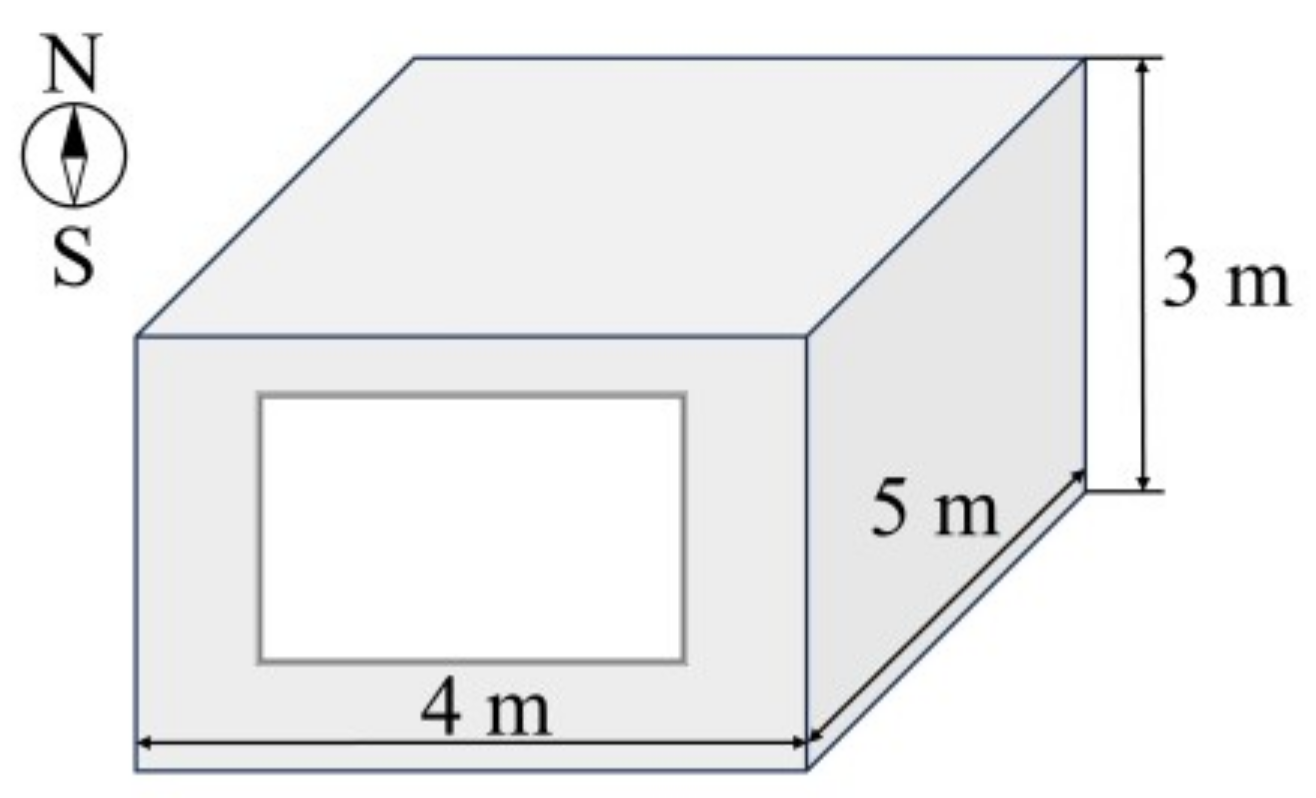
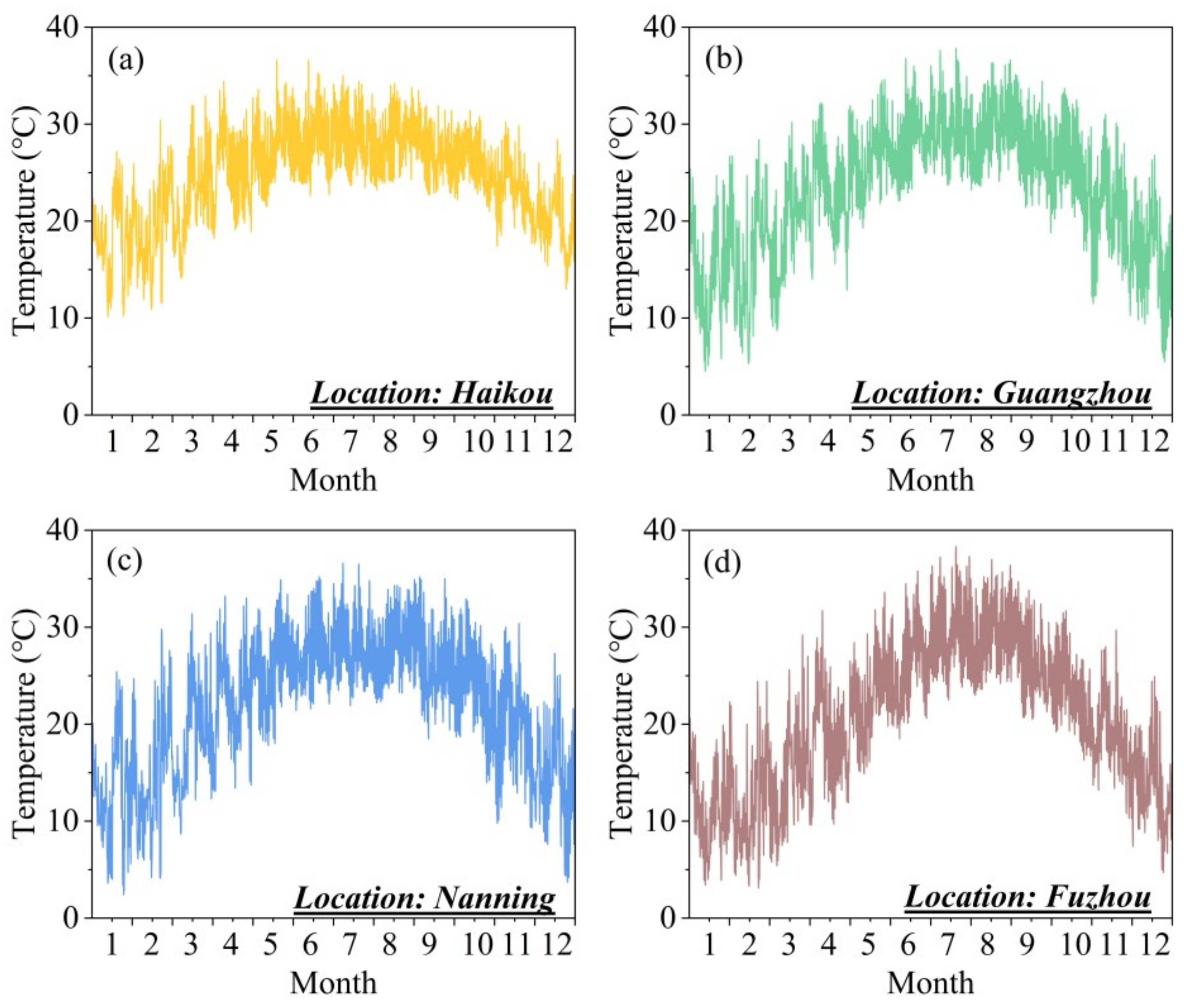
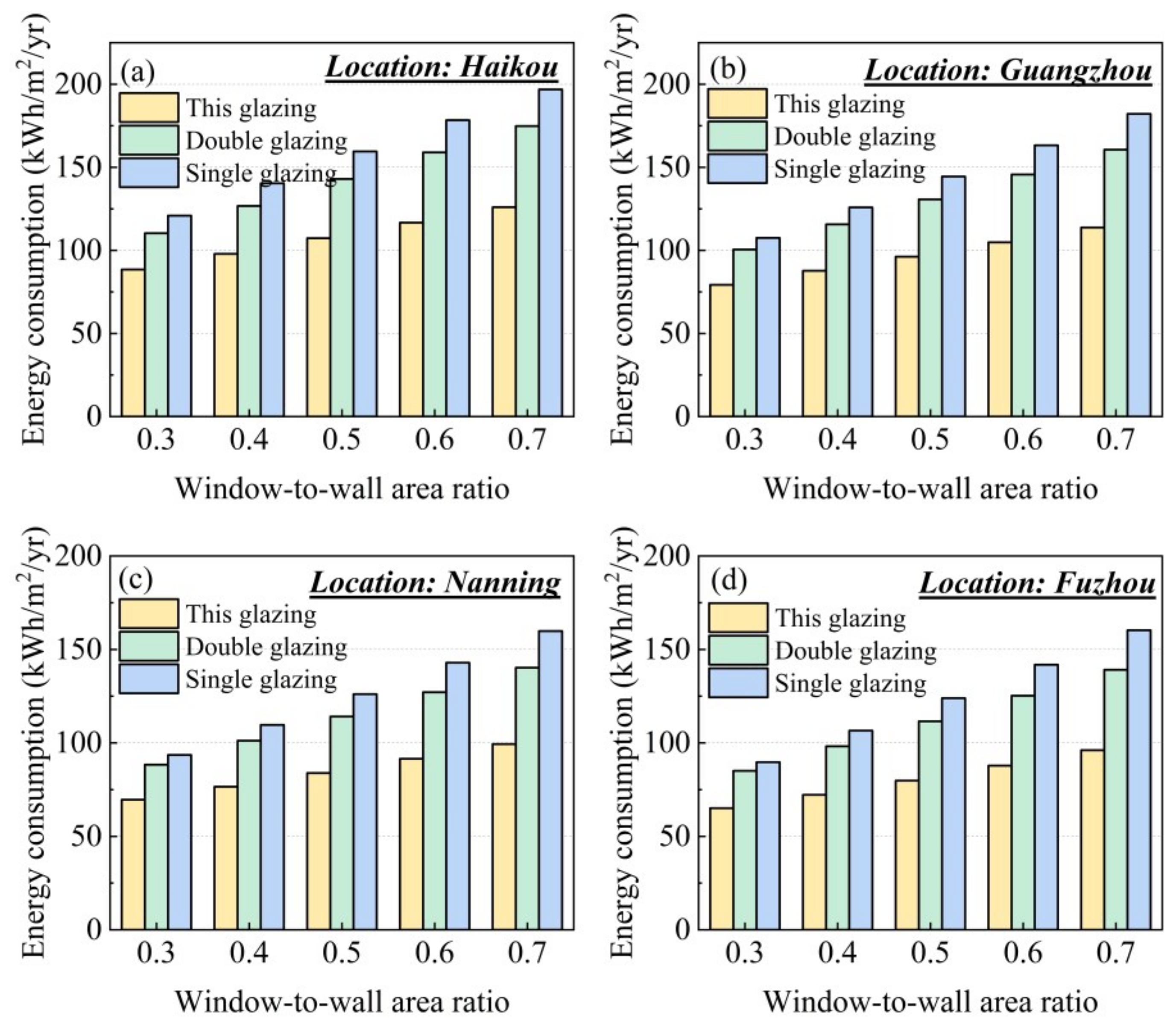
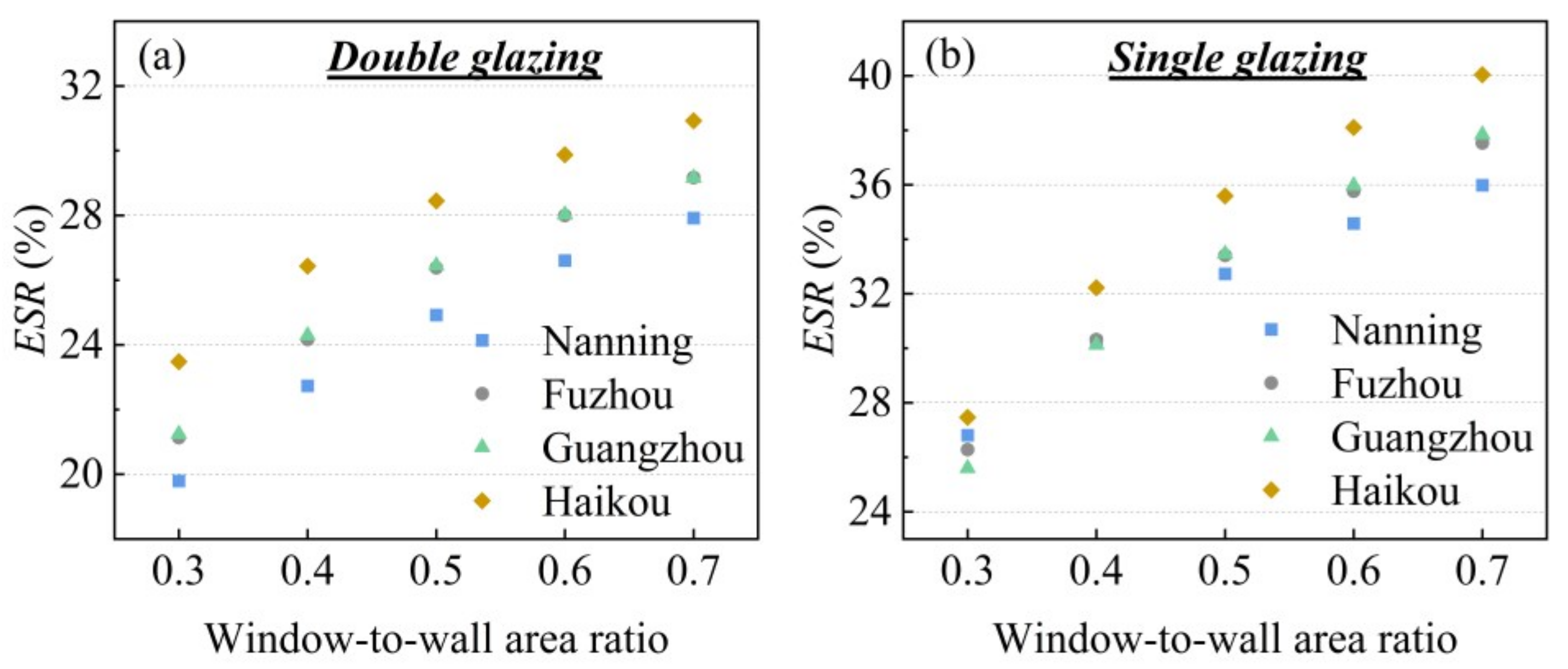

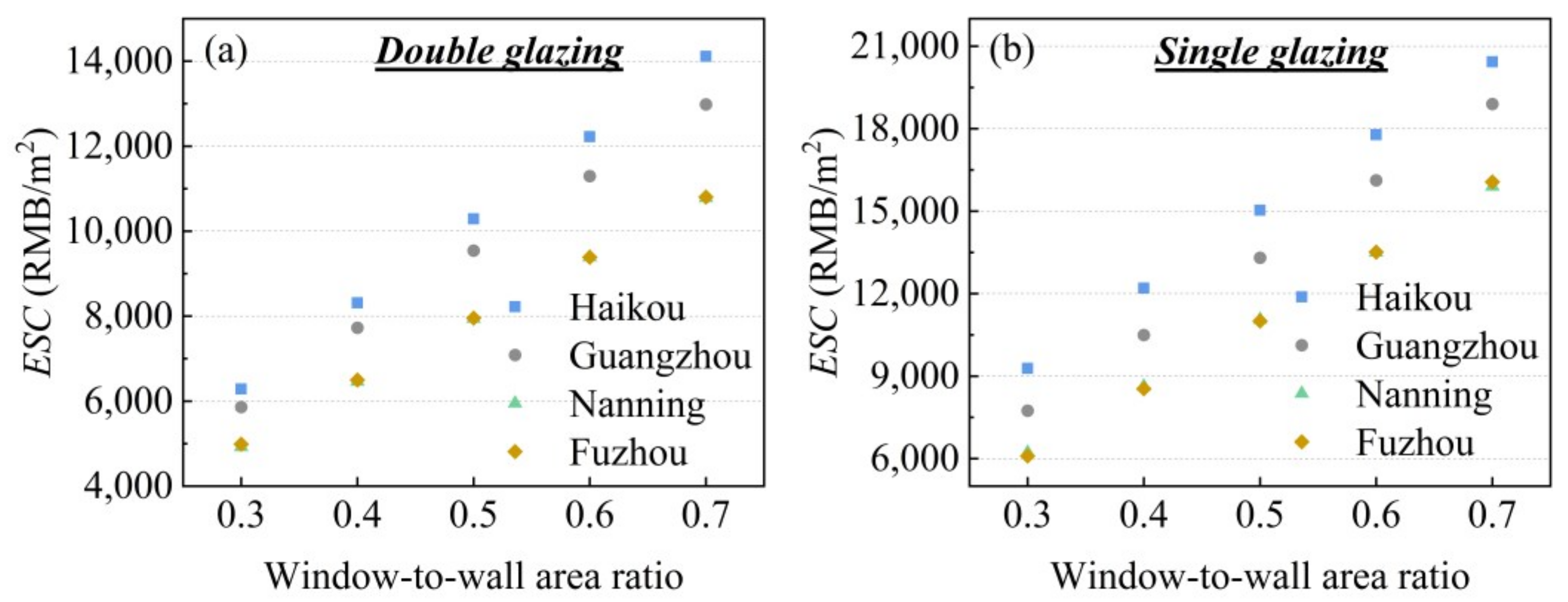
| fv,AR = 1.3 | fv,AR = 1.5 | Ratio |
|---|---|---|
| 1 × 10−6 | 1 × 10−7 | 10 |
| 1 × 10−6 | 2.5 × 10−7 | 4 |
| 1 × 10−6 | 5 × 10−7 | 2 |
| 1 × 10−6 | 7.5 × 10−7 | 1.33 |
| 1 × 10−6 | 1 × 10−6 | 1 |
| Locations | Longitude and Latitude | Altitude | Climate |
|---|---|---|---|
| Haikou | 20° N, 110°15′ E | 63.5 m | Tropical maritime monsoon climate |
| Guangzhou | 23°13′ N, 113°29′ E | 70.7 m | Subtropical maritime monsoon climate |
| Nanning | 22°38′ N, 108°13′ E | 121.6 m | Subtropical monsoon climate |
| Fuzhou | 26°05′ N, 119°17′ E | 84 m | Subtropical monsoon climate |
| Thickness (mm) | U (W/m2K) | SHGC | Tsol | |
|---|---|---|---|---|
| This glazing | 3 | 3.09 | 0.547 | 0.476 |
| Double glazing | 6 | 2.97 | 0.64 | 0.607 |
| Single glazing | 6 | 5.41 | 0.823 | 0.791 |
| Location | Electricity Price (RMB/kWh) |
|---|---|
| Haikou | 0.9183 |
| Guangzhou | 0.8802 |
| Nanning | 0.8383 |
| Fuzhou | 0.7983 |
| Window Type | Initial Cost (RMB/m2) |
|---|---|
| Silica aerogel | 200 |
| Double glazing | 102 |
| Single glazing | 30 |
Disclaimer/Publisher’s Note: The statements, opinions and data contained in all publications are solely those of the individual author(s) and contributor(s) and not of MDPI and/or the editor(s). MDPI and/or the editor(s) disclaim responsibility for any injury to people or property resulting from any ideas, methods, instructions or products referred to in the content. |
© 2025 by the authors. Licensee MDPI, Basel, Switzerland. This article is an open access article distributed under the terms and conditions of the Creative Commons Attribution (CC BY) license (https://creativecommons.org/licenses/by/4.0/).
Share and Cite
Yang, H.; Huang, M.; Yang, M.; Zhang, X.; Du, M. Precision Solar Spectrum Filtering in Aerogel Windows via Synergistic ITO-Ag Nanoparticle Doping for Hot-Climate Energy Efficiency. Gels 2025, 11, 553. https://doi.org/10.3390/gels11070553
Yang H, Huang M, Yang M, Zhang X, Du M. Precision Solar Spectrum Filtering in Aerogel Windows via Synergistic ITO-Ag Nanoparticle Doping for Hot-Climate Energy Efficiency. Gels. 2025; 11(7):553. https://doi.org/10.3390/gels11070553
Chicago/Turabian StyleYang, Huilin, Maoquan Huang, Mingyang Yang, Xuankai Zhang, and Mu Du. 2025. "Precision Solar Spectrum Filtering in Aerogel Windows via Synergistic ITO-Ag Nanoparticle Doping for Hot-Climate Energy Efficiency" Gels 11, no. 7: 553. https://doi.org/10.3390/gels11070553
APA StyleYang, H., Huang, M., Yang, M., Zhang, X., & Du, M. (2025). Precision Solar Spectrum Filtering in Aerogel Windows via Synergistic ITO-Ag Nanoparticle Doping for Hot-Climate Energy Efficiency. Gels, 11(7), 553. https://doi.org/10.3390/gels11070553








